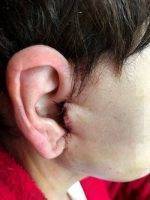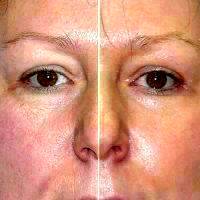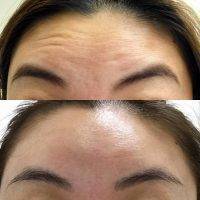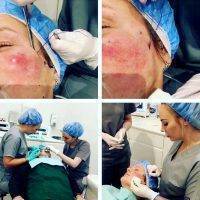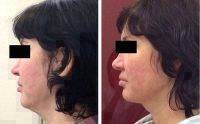Facelift, or rhytidectomy, is an aesthetic operation aimed at restoring the ideal contours of the face and neck, rejuvenating the appearance and eliminating wrinkles. This operation is usually indicated for women and men after 40 years old. People resort to surgical rejuvenation and at an earlier age, with some features of the structure of the face, for example, with a low location of the hyoid bone, an underdeveloped chin, a narrowed lower jaw.
Facelift allows you to solve many aesthetic problems caused by age-related skin changes. First of all, the procedure is effective for eliminating ptosis of soft tissues in the middle third of the face, under the chin, along the line of the contour of the lower jaw. Facelift is carried out to reduce the flabbiness of the skin in the neck, smoothing large folds and wrinkles, restoring contours of the face.
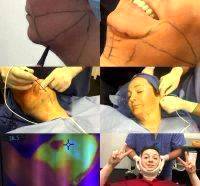
Lower Rhytidectomy Rejuvenates The Bottom Third Of The Face
The methods of minimally invasive facial surgery guarantee a quicker recovery period without swelling and bruising.
Types of operation
There are 3 types of facelift depending on the level of surgical intervention:
- Skin lifting is a low-traumatic procedure, in which excess skin of the face and neck is tighten and removed
- SMAS facelift – the skin and the Superficial Musculoaponeurotic System(SMAS) are fixed in a new position; The operation is characterized by a more lasting effect.
- Endoscopic facelift is the least traumatic operation performed using modern optical endoscopic equipment, which is inserted through small incisions of the skin in the area of the hairline.
Types of endoscopic facelift

A Rhytidectomy Gives A More Youthful Facial Appearance
And the further the progress, these alternative ways of rejuvenation for most people become more accessible. Facelift is an effective method that not only restores youth, but also brings psychological stability, self-confidence and one’s own strength.
There is a variety of types of facelift, but the most popular and effective method is an endoscopic facelift. Endoscopic facelift is good because there is not a large area of surgical intervention. Accurate small incisions are through the hair zone, and subsequently they are virtually invisible.
A special feature of the operation is an increase with the help of an endoscope of small vessels and nerves. Therefore, there is practically no risk of injury. And this, in turn, facilitates the course of the postoperative period and reduces the incidence of complications.Endoscopic facelift is recommended for patients aged 35-50 years with small age-related face changes. This type of operation is not chosen for severe ptosis of the skin and soft tissues.
Endoscopic lifting has the following varieties:
The lift of the upper part of the face affects the upper part of the face. The face becomes more open, soft. The main goal is to raise the line of eyebrows, smooth wrinkles on the forehead and nose.
Lifting the middle third of the face.
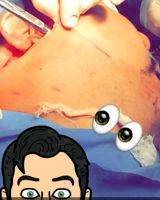
Facelift Usually Involves The Removal Of Excess Facial Skin
Lower Face Lift
The main goal is to form the bottom line of the face. Wrinkles of the neck, ugly double chin, removal of excess skin all this is performed during the lower endoscopic facelift. All three types of lifting can be carried out either individually or combined in various combinations. Everything will depend on the objectives of the operation and the expected effect.
In any case, the choice of the method is determined by the surgeon, who will make an accurate selection of the method individually for each client.
Indications for facelift
- Deep mimic and static wrinkles of the forehead, between the eyebrows;
- Nasolabial folds;
- drooping eyelids, the outer corners of the eyes;
- Vertical wrinkles on cheeks;
- Double chin;
- Ptosis of soft tissues of cheeks.
Contraindications to facelift
- Skin diseases (scleroderma, systemic lupus erythematosus, etc.);
- Inflammatory processes in the stage of exacerbation;
- Serious pathology of the cardiovascular, respiratory system;
- Renal, hepatic insufficiency;
- Diabetes;
- Bleeding disorders;
- Autoimmune diseases.
Preoperative period
- Consultation of the surgeon.
- Identification of problem areas.
- Preoperative diagnostics.
- Consultation of an anesthesiologist.
Operation
- The time is from 1.5 to 3.5 hours.
- Type of anesthesia: general anesthesia.
Postoperative period
- Stay in the hospital is 1 day.
- Duration of pain and discomfort is from 2 to 5 days.
- Pain medications: prescribed by a doctor.
- Dressings: yes.
- Seams removal for 7-14 days (depending on the type of operation)
- Restrictions on physical activity.
Results of facelift
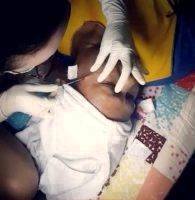
A Thread Rhytidectomy Is A Safe, Convenient Alternative To Traditional Rhytidectomy
Facelift. Recovery after facelift.
On the first day after facelift, your physician and medical personnel are next to you: they help to solve pressing problems, since an elastic bandage is applied on a face that can limit the usual movements and make it difficult to eat.
The areas where the incisions were made may be slightly reminiscent about surgery, but here it is sufficient to take perioral anesthetics. Patients with a high pain threshold and do not prefer to take painkillers, because they do not see the need for it, there are no painful sensations.
On the second day, bandaging and replacement of bandages are carried out: seams and wounds are treated with special medicines for the speedy healing. The state of health on the second day is usually much better, but the face looks very swollen, the eyes can hardly open.In the first three days after surgery, edema and hematomas reach their maximum, however, beauty requires certain victims. On the third day, as a rule, the patient is discharged, and he is on an outpatient treatment. Now you need to follow simple rules, and then the recovery period after a facelift will be easy.
Two days after the operation you will have to refrain from washing your head. If you regularly dye your hair, then you should make the coloration on the eve of the operation. After facelifting, you will not be able to visit a hairdresser before 7-8 weeks later.
There may be uncomfortable sensations in the mouth area, so it is recommended to use mainly liquid or soft food. Physical activity of any kind is necessary to eliminate and minimize having sex in the first 2-3 weeks after surgery.It is worth mentioning that for some time after facelift, in some areas of the face there may be a decreased sensitivity, but it is gradually restored completely. Some patients go to work after 3 weeks. This is due to the fact that the main edema and bruising will going down.
Every day the face will become more beautiful and attractive. You can forget about bags under the eyes, deep wrinkles, the second chin. However, the final result of facelifting should be assessed only after 5-6 months.
